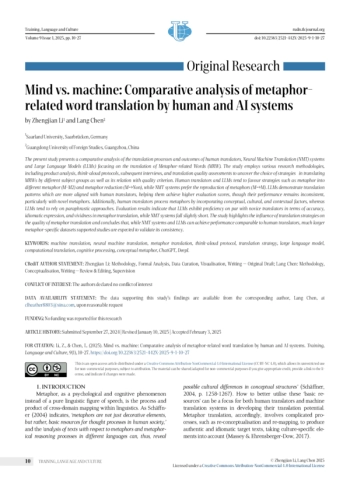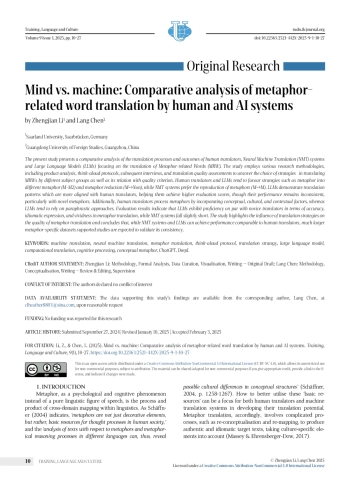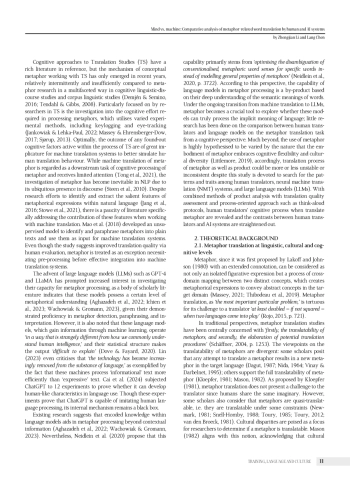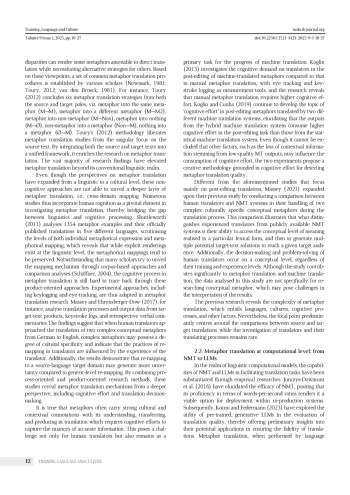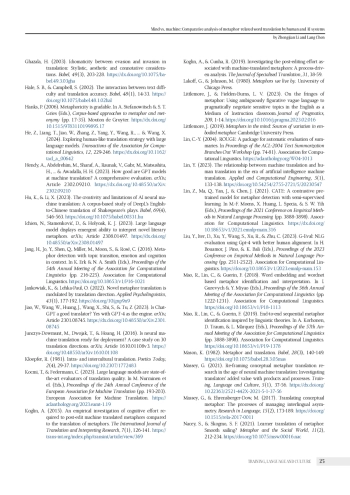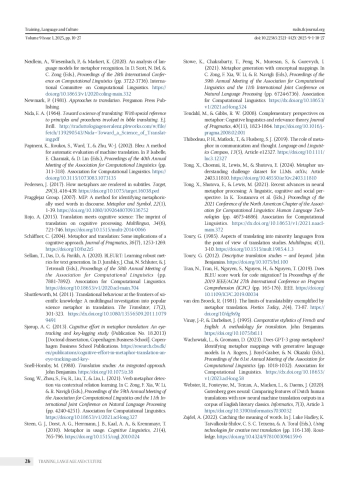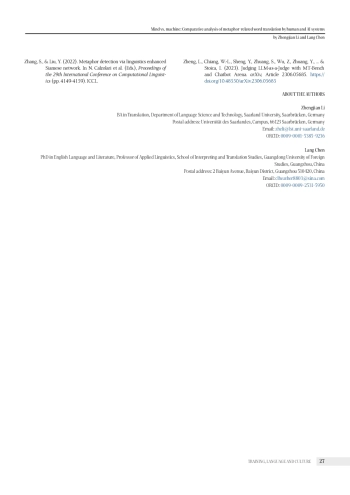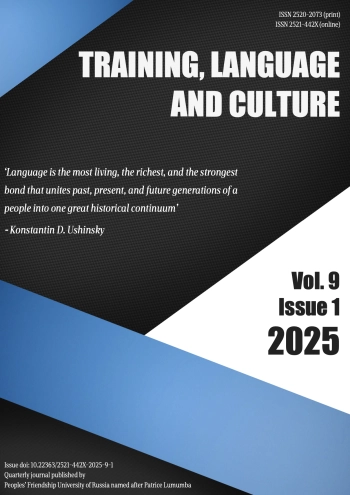The present study presents a comparative analysis of the translation processes and outcomes of human translators, Neural Machine Translation (NMT) systems and Large Language Models (LLMs) focusing on the translation of Metaphor-related Words (MRW). The study employs various research methodologies, including product analysis, think-aloud protocols, subsequent interviews, and translation quality assessments to uncover the choice of strategies in translating MRWs by different subject groups as well as its relation with quality criterion. Human translators and LLMs tend to favour strategies such as metaphor into different metaphor (M-M2) and metaphor reduction (M→Non), while NMT systems prefer the reproduction of metaphors (M→M). LLMs demonstrate translation patterns which are more aligned with human translators, helping them achieve higher evaluation scores, though their performance remains inconsistent, particularly with novel metaphors. Additionally, human translators process metaphors by incorporating conceptual, cultural, and contextual factors, whereas LLMs tend to rely on paraphrastic approaches. Evaluation results indicate that LLMs exhibit proficiency on par with novice translators in terms of accuracy, idiomatic expression, and vividness in metaphor translation, while NMT systems fall slightly short. The study highlights the influence of translation strategies on the quality of metaphor translation and concludes that, while NMT systems and LLMs can achieve performance comparable to human translators, much larger metaphor-specific datasets supported studies are expected to validate its consistency.
Идентификаторы и классификаторы
Metaphor, as a psychological and cognitive phenomenon instead of a pure linguistic figure of speech, is the process and product of cross-domain mapping within linguistics. As Schäffner (2004) indicates, ‘metaphors are not just decorative elements, but rather, basic resources for thought processes in human society,’ and the ‘analysis of texts with respect to metaphors and metaphorical reasoning processes in different languages can, thus, reveal possible cultural differences in conceptual structures’ (Schäffner, 2004, p. 1258-1267).
Список литературы
1. Aghazadeh, E., Fayyaz, M., & Yaghoobzadeh, Y. (2022). Metaphors in pre-trained language models: Probing and generalization across datasets and languages. In S. Muresan, P. Nakov, & A. Villavicencio (Eds.), Proceedings of the 60th Annual Meeting of the Association for Computational Linguistics (pp. 2037-2050). Association for Computational Linguistics. DOI: 10.18653/v1/2022.acl-long.144
2. Bambini, V., Gentili, C., Ricciardi, E., Bertinetto, P. M., & Pietrini, P. (2011). Decomposing metaphor processing at the cognitive and neural level through functional magnetic resonance imaging. Brain Research Bulletin, 86(3-4), 203-216. DOI: 10.1016/j.brainresbull.2011.07.015
3. Banerjee, S., & Lavie, A. (2005). METEOR: An automatic metric for MT evaluation with improved correlation with human judgments. In J. Goldstein, A. Lavie, C.-Y. Lin, & C. Voss (Eds.), Proceedings of the ACL Workshop on Intrinsic and Extrinsic Evaluation Measures for Machine Translation and/or Summarization (pp. 65-72). Association for Computational Linguistics. https://aclanthology.org/W05-0909.
4. Briva-Iglesias, V., O’Brien, S., & Cowan, B. R. (2023). The impact of traditional and interactive post-editing on machine translation user experience, quality, and productivity. Translation, Cognition & Behavior, 6(1), 60-86. DOI: 10.1075/tcb.00077.bri EDN: DBVGSP
5. Brown, T., Mann, B., Ryder, N., Subbiah, M., Kaplan, J. D., Dhariwal, P.,... & Amodei, D. (2020). Language models are few-shot learners. Advances in Neural Information Processing Systems, 33, 1877-1901.
6. Cai, Z. G., Duan, X., Haslett, D. A., Wang, S., & Pickering, M. J. (2024). Do large language models resemble humans in language use? arXiv, Article 2303.08014. DOI: 10.48550/arXiv.2303.08014
7. Choi, M., Lee, S., Choi, E., Park, H., Lee, J., Lee, D., & Lee, J. (2021). MelBERT: Metaphor detection via contextualized late interaction using metaphorical identification theories. In K. Toutanova et al. (Eds.), Proceedings of the 2021 Conference of the North American Chapter of the Association for Computational Linguistics: Human Language Technologies (pp. 1763-1773). Association for Computational Linguistics. DOI: 10.18653/v1/2021.naacl-main.141
8. Clark, E., Celikyilmaz, A., & Smith, N. A. (2019). Sentence mover’s similarity: Automatic evaluation for multi-sentence texts. In A. Korhonen, D. Traum, & L. Màrquez (Eds.), Proceedings of the 57th Annual Meeting of the Association for Computational Linguistics (pp. 2748-2760). Association for Computational Linguistics. DOI: 10.18653/v1/P19-1264
9. Croft, W., & Cruse, D. A. (2004). Cognitive linguistics. Cambridge University Press. DOI: 10.1017/CBO9780511803864
10. Dagut, M. (1987). More about the translatability of metaphor. Babel, 33(2), 77-83. DOI: 10.1075/babel.33.2.06dag
11. Demjén, Z., & Semino, E. (2016). Introduction: Metaphor and language. In E. Semino & Z. Demjén (Eds.), The Routledge handbook of metaphor and language (pp. 1-10). Routledge.
12. Do Dinh, E.-L., & Gurevych, I. (2016). Token-level metaphor detection using neural networks. In B. Beigman Klebanov, E. Shutova, & P. Lichtenstein (Eds.), Proceedings of the Fourth Workshop on Metaphor in NLP (pp. 28-33). Association for Computational Linguistics. DOI: 10.18653/v1/W16-1104
13. Dove, G., & Fayard, A.-L. (2020). Monsters, metaphors, and machine learning. In Proceedings of the 2020 CHI Conference on Human Factors in Computing Systems (pp. 1-17). Association for Computing Machinery.
14. Gao, R., Lin, Y., Zhao, N., & Cai, Z. G. (2024). Machine translation of Chinese classical poetry: A comparison among ChatGPT, Google Translate, and DeepL Translator. Humanities and Social Sciences Communications, 11(1), Article 835. DOI: 10.1057/s41599-024-03363-0
15. Ge, M., Mao, R., & Cambria, E. (2023). A survey on computational metaphor processing techniques: From identification, interpretation, generation to application. Artificial Intelligence Review, 56, 1829-1895. DOI: 10.1007/s10462-023-10564-7 EDN: TWQIYG
16. Ghazala, H. (2003). Idiomaticity between evasion and invasion in translation: Stylistic, aesthetic and connotative considerations. Babel, 49(3), 203-228. DOI: 10.1075/babel.49.3.03gha
17. Hale, S. B., & Campbell, S. (2002). The interaction between text difficulty and translation accuracy. Babel, 48(1), 14-33. DOI: 10.1075/babel.48.1.02hal
18. Hanks, P. (2006). Metaphoricity is gradable. In A. Stefanowitsch & S. T. Gries (Eds.), Corpus-based approaches to metaphor and metonymy (pp. 17-35). Mouton de Gruyter. DOI: 10.1515/9783110199895.17
19. He, Z., Liang, T., Jiao, W., Zhang, Z., Yang, Y., Wang, R., … & Wang, X. (2024). Exploring human-like translation strategy with large language models. Transactions of the Association for Computational Linguistics, 12, 229-246. DOI: 10.1162/tacl_a_00642 EDN: SSYTSJ
20. Hendy, A., Abdelrehim, M., Sharaf, A., Raunak, V., Gabr, M., Matsushita, H., … & Awadalla, H. H. (2023). How good are GPT models at machine translation? A comprehensive evaluation. arXiv, Article 2302.09210. DOI: 10.48550/arXiv.2302.09210
21. Hu, K., & Li, X. (2023). The creativity and limitations of AI neural machine translation: A corpus-based study of DeepL’s English-to-Chinese translation of Shakespeare’s plays. Babel, 69(4), 546-563. DOI: 10.1075/babel.00331.hu EDN: BPVIMN
22. Ichien, N., Stamenković, D., & Holyoak, K. J. (2023). Large language model displays emergent ability to interpret novel literary metaphors. arXiv, Article 2308.01497. DOI: 10.48550/arXiv.2308.01497
23. Jang, H., Jo, Y., Shen, Q., Miller, M., Moon, S., & Rosé, C. (2016). Metaphor detection with topic transition, emotion and cognition in context. In K. Erk & N. A. Smith (Eds.), Proceedings of the 54th Annual Meeting of the Association for Computational Linguistics (pp. 216-225). Association for Computational Linguistics. DOI: 10.18653/v1/P16-1021
24. Jankowiak, K., & Lehka-Paul, O. (2022). Novel metaphor translation is modulated by translation direction. Applied Psycholinguistics, 43(1), 177-192. https://doi.org/10/gnp9n9. EDN: XJBBNN
25. Jiao, W., Wang, W., Huang, J., Wang, X., Shi, S., & Tu, Z. (2023). Is ChatGPT a good translator? Yes with GPT-4 as the engine. arXiv, Article 2301.08745. DOI: 10.48550/arXiv.2301.08745
26. Junczys-Dowmunt, M., Dwojak, T., & Hoang, H. (2016). Is neural machine translation ready for deployment? A case study on 30 translation directions. arXiv, Article 1610.01108v3. DOI: 10.48550/arXiv.1610.01108
27. Kloepfer, R. (1981). Intra- and intercultural translation. Poetics Today, 2(4), 29-37. DOI: 10.2307/1772483
28. Kocmi, T., & Federmann, C. (2023). Large language models are state-of-the-art evaluators of translation quality. In M. Nurminen et el. (Eds.), Proceedings of the 24th Annual Conference of the European Association for Machine Translation (pp. 193-203). European Association for Machine Translation. https://aclanthology.org/2023.eamt-1.19.
29. Koglin, A. (2015). An empirical investigation of cognitive effort required to post-edit machine translated metaphors compared to the translation of metaphors. The International Journal of Translation and Interpreting Research, 7(1), 126-141. https://trans-int.org/index.php/transint/article/view/369.
30. Koglin, A., & Cunha, R. (2019). Investigating the post-editing effort associated with machine-translated metaphors: A process-driven analysis. The Journal of Specialised Translation, 31, 38-59.
31. Lakoff, G., & Johnson, M. (1980). Metaphors we live by. University of Chicago Press.
32. Littlemore, J., & Fielden-Burns, L. V. (2023). On the fringes of metaphor: Using ambiguously figurative vague language to pragmatically negotiate sensitive topics in the English as a Medium of Instruction classroom. Journal of Pragmatics, 209, 1-14. DOI: 10.1016/j.pragma.2023.02.016 EDN: FLRBZA
33. Littlemore, J. (2019). Metaphors in the mind: Sources of variation in embodied metaphor. Cambridge University Press. EDN: YFHLOU
34. Lin, C.-Y. (2004). ROUGE: A package for automatic evaluation of summaries. In Proceedings of the ACL-2004 Text Summarization Branches Out Workshop (pp. 74-81). Association for Computational Linguistics. https://aclanthology.org/W04-1013.
35. Lin, Y. (2023). The relationship between machine translation and human translation in the era of artificial intelligence machine translation. Applied and Computational Engineering, 5(1), 133-138. DOI: 10.54254/2755-2721/5/20230547 EDN: IGWUNO
36. Lin, Z., Ma, Q., Yan, J., & Chen, J. (2021). CATE: A contrastive pre-trained model for metaphor detection with semi-supervised learning. In M.-F. Moens, X. Huang, L. Specia, & S. W. Yih (Eds.), Proceedings of the 2021 Conference on Empirical Methods in Natural Language Processing (pp. 3888-3898). Association for Computational Linguistics. DOI: 10.18653/v1/2021.emnlp-main.316
37. Liu, Y., Iter, D., Xu, Y., Wang, S., Xu, R., & Zhu, C. (2023). G-Eval: NLG evaluation using Gpt-4 with better human alignment. In H. Bouamor, J. Pino, & K. Bali (Eds.), Proceedings of the 2023 Conference on Empirical Methods in Natural Language Processing (pp. 2511-2522). Association for Computational Linguistics. DOI: 10.18653/v1/2023.emnlp-main.153
38. Mao, R., Lin, C., & Guerin, F. (2018). Word embedding and wordnet based metaphor identification and interpretation. In I. Gurevych & Y. Miyao (Eds.), Proceedings of the 56th Annual Meeting of the Association for Computational Linguistics (pp. 1222-1231). Association for Computational Linguistics. DOI: 10.18653/v1/P18-1113
39. Mao, R., Lin, C., & Guerin, F. (2019). End-to-end sequential metaphor identification inspired by linguistic theories. In A. Korhonen, D. Traum, & L. Màrquez (Eds.), Proceedings of the 57th Annual Meeting of the Association for Computational Linguistics (pp. 3888-3898). Association for Computational Linguistics. DOI: 10.18653/v1/P19-1378
40. Mason, K. (1982). Metaphor and translation. Babel, 28(3), 140-149. DOI: 10.1075/babel.28.3.05mas
41. Massey, G. (2021). Re-framing conceptual metaphor translation research in the age of neural machine translation: Investigating translators’ added value with products and processes. Training, Language and Culture, 5(1), 37-56. DOI: 10.22363/2521-442X-2021-5-1-37-56 EDN: SZDVKW
42. Massey, G., & Ehrensberger-Dow, M. (2017). Translating conceptual metaphor: The processes of managing interlingual asymmetry. Research in Language, 15(2), 173-189. DOI: 10.1515/rela-2017-0011
43. Nacey, S., & Skogmo, S. F. (2021). Learner translation of metaphor: Smooth sailing? Metaphor and the Social World, 11(2), 212-234. DOI: 10.1075/msw.00016.nac EDN: AHBJPI
44. Neidlein, A., Wiesenbach, P., & Markert, K. (2020). An analysis of language models for metaphor recognition. In D. Scott, N. Bel, & C. Zong (Eds.), Proceedings of the 28th International Conference on Computational Linguistics (pp. 3722-3736). International Committee on Computational Linguistics. DOI: 10.18653/v1/2020.coling-main.332
45. Newmark, P. (1981). Approaches to translation. Pergamon Press Publishing.
46. Nida, E. A. (1964). Toward a science of translating: With special reference to principles and procedures involved in bible translating. E.J. Brill. http://traduttologiageneralenz.pbworks.com/w/file/fetch/139290543/Nida-Toward_a_Science_of_Translating.pdf.
47. Papineni, K., Roukos, S., Ward, T., & Zhu, W.-J. (2002). Bleu: A method for automatic evaluation of machine translation. In P. Isabelle, E. Charniak, & D. Lin (Eds.), Proceedings of the 40th Annual Meeting of the Association for Computational Linguistics (pp. 311-318). Association for Computational Linguistics. DOI: 10.3115/1073083.1073135
48. Pedersen, J. (2017). How metaphors are rendered in subtitles. Target, 29(3), 416-439. DOI: 10.1075/target.16038.ped
49. Pragglejaz Group. (2007). MIP: A method for identifying metaphorically used words in discourse. Metaphor and Symbol, 22(1), 1-39. DOI: 10.1080/10926480709336752
50. Rojo, A. (2015). Translation meets cognitive science: The imprint of translation on cognitive processing. Multilingua, 34(6), 721-746. DOI: 10.1515/multi-2014-0066
51. Schäffner, C. (2004). Metaphor and translation: Some implications of a cognitive approach. Journal of Pragmatics, 36(7), 1253-1269. https://doi.org/10/fsz2z5. EDN: WUUHDK
52. Sellam, T., Das, D., & Parikh, A. (2020). BLEURT: Learning robust metrics for text generation. In D. Jurafsky, J. Chai, N. Schluter, & J. Tetreault (Eds.), Proceedings of the 58th Annual Meeting of the Association for Computational Linguistics (pp. 7881-7892). Association for Computational Linguistics. DOI: 10.18653/v1/2020.acl-main.704
53. Shuttleworth, M. (2011). Translational behaviour at the frontiers of scientific knowledge: A multilingual investigation into popular science metaphor in translation. The Translator, 17(2), 301-323. DOI: 10.1080/13556509.2011.10799491
54. Sjørup, A. C. (2013). Cognitive effort in metaphor translation: An eye-tracking and key-logging study (Publication No. 18.2013) [Doctoral dissertation, Copenhagen Business School]. Copenhagen Business School Publications. https://research.cbs.dk/en/publications/cognitive-effort-in-metaphor-translation-an-eye-tracking-and-key-.
55. Snell-Hornby, M. (1988). Translation studies: An integrated approach. John Benjamins. DOI: 10.1075/z.38
56. Song, W., Zhou, S., Fu, R., Liu, T., & Liu, L. (2021). Verb metaphor detection via contextual relation learning. In C. Zong, F. Xia, W. Li, & R. Navigli (Eds.), Proceedings of the 59th Annual Meeting of the Association for Computational Linguistics and the 11th International Joint Conference on Natural Language Processing (pp. 4240-4251). Association for Computational Linguistics. DOI: 10.18653/v1/2021.acl-long.327
57. Steen, G. J., Dorst, A. G., Herrmann, J. B., Kaal, A. A., & Krennmayr, T. (2010). Metaphor in usage. Cognitive Linguistics, 21(4), 765-796. DOI: 10.1515/cogl.2010.024
58. Stowe, K., Chakrabarty, T., Peng, N., Muresan, S., & Gurevych, I. (2021). Metaphor generation with conceptual mappings. In C. Zong, F. Xia, W. Li, & R. Navigli (Eds.), Proceedings of the 59th Annual Meeting of the Association for Computational Linguistics and the 11th International Joint Conference on Natural Language Processing (pp. 6724-6736). Association for Computational Linguistics. DOI: 10.18653/v1/2021.acl-long.524
59. Tendahl, M., & Gibbs, R. W. (2008). Complementary perspectives on metaphor: Cognitive linguistics and relevance theory. Journal of Pragmatics, 40(11), 1823-1864. DOI: 10.1016/j.pragma.2008.02.001
60. Thibodeau, P. H., Matlock, T., & Flusberg, S. J. (2019). The role of metaphor in communication and thought. Language and Linguistics Compass, 13(5), Article e12327. DOI: 10.1111/lnc3.12327
61. Tong, X., Choenni, R., Lewis, M., & Shutova, E. (2024). Metaphor understanding challenge dataset for LLMs. arXiv, Article 2403.11810. DOI: 10.48550/arXiv.2403.11810
62. Tong, X., Shutova, E., & Lewis, M. (2021). Recent advances in neural metaphor processing: A linguistic, cognitive and social perspective. In K. Toutanova et al. (Eds.,) Proceedings of the 2021 Conference of the North American Chapter of the Association for Computational Linguistics: Human Language Technologies (pp. 4673-4686). Association for Computational Linguistics. DOI: 10.18653/v1/2021.naacl-main.372
63. Toury, G. (1985). Aspects of translating into minority languages from the point of view of translation studies. Multilingua, 4(1), 3-10. DOI: 10.1515/mult.1985.4.1.3
64. Toury, G. (2012). Descriptive translation studies - and beyond. John Benjamins. DOI: 10.1075/btl.100
65. Tran, N., Tran, H., Nguyen, S., Nguyen, H., & Nguyen, T. (2019). Does BLEU score work for code migration? In Proceedings of the 2019 IEEE/ACM 27th International Conference on Program Comprehension (ICPC) (pp. 165-176). IEEE. DOI: 10.1109/ICPC.2019.00034
66. van den Broeck, R. (1981). The limits of translatability exemplified by metaphor translation. Poetics Today, 2(4), 73-87. https://doi.org/10/dg9s9g.
67. Vinay, J.-P., & Darbelnet, J. (1995). Comparative stylistics of French and English: A methodology for translation. John Benjamins. DOI: 10.1075/btl.11
68. Wachowiak, L., & Gromann, D. (2023). Does GPT-3 grasp metaphors? Identifying metaphor mappings with generative language models. In A. Rogers, J. Boyd-Graber, & N. Okazaki (Eds.), Proceedings of the 61st Annual Meeting of the Association for Computational Linguistics (pp. 1018-1032). Association for Computational Linguistics. DOI: 10.18653/v1/2023.acl-long.58
69. Webster, R., Fonteyne, M., Tezcan, A., Macken, L., & Daems, J. (2020). Gutenberg goes neural: Comparing features of Dutch human translations with raw neural machine translation outputs in a corpus of English literary classics. Informatics, 7(3), Article 3. DOI: 10.3390/informatics7030032
70. Zajdel, A. (2022). Catching the meaning of words. In J. Luke Hadley, K. Taivalkoski-Shilov, C. S. C. Teixeira, & A. Toral (Eds.), Using technologies for creative text translation (pp. 116-138). Routledge. DOI: 10.4324/9781003094159-6
71. Zhang, S., & Liu, Y. (2022). Metaphor detection via linguistics enhanced Siamese network. In N. Calzolari et al. (Eds.), Proceedings of the 29th International Conference on Computational Linguistics (pp. 4149-4159). ICCL.
72. Zheng, L., Chiang, W.-L., Sheng, Y., Zhuang, S., Wu, Z., Zhuang, Y., … & Stoica, I. (2023). Judging LLM-as-a-Judge with MT-Bench and Chatbot Arena. arXiv, Article 2306.05685.
Выпуск
Другие статьи выпуска
In a thirty-year career as a teacher of English as a foreign and second language, Nik Peachey set up his own online system for producing weekly lesson plans for teachers, focusing on social issues and addressing areas of language use of special value to language teachers wanting to introduce new topics and activities to their classes at different levels of proficiency. Like many of his colleagues, he has moved beyond the use of the computer and the Internet to produce and circulate lesson plans and now has published an online book on the role of artificial intelligence and its applications, such as ChatGPT, in language learning and teaching. Entitled The Manual of AI-Mediated Autonomous Teacher Development, the book is available online. Nik Peachey takes teachers of English through the theory and practice of artificial intelligence in a clear, simple and non-scientific approach which is adaptable to all teachers of foreign and second languages helping them create and develop new teaching materials to interest and involve their students in the learning process.
The study aims to examine how movie titles are translated from English to Vietnamese under the light of the translation methods proposed by Newmark (1988). To fulfil this research objective, the researcher uses a linguistic corpus consisting of 83 pairs of movie titles collected randomly from various sources. Two research methods are employed, including discourse analysis to analyse the linguistic components used in the original and translated titles and translation comparative to compare the linguistic and semantic similarities and differences between the two versions to identify what methods have been used in each title translation. The research findings show that of the eight methods presented by Newmark (1988), only five are employed, including faithful translation, semantic translation, idiomatic translation, free translation and adaptation, together with the two additional ones, including keeping the title unchanged and creating a new title, of which faithful translation has the highest frequency of use, while the least common method is idiomatic translation. The findings indicate that the choice of translation methods depends on the text types and translators’ consideration of the linguistic, semantic and pragmatic transfer in the translation process. These findings partly align with the earlier research of Newmark and other scholars, thereby further consolidating the theories related to translation methods while some new findings are identified as the contributions of this study to the research topic. Based on the findings, some implications have been made on how to translate movie titles in general and other text types in particular.
The evolution of musical terminology is a dynamic process influenced by historical, linguistic and social factors. While initially confined to professional discourse, musical terms have been increasingly used in non-professional contexts, necessitating further investigation into this phenomenon. This study aims to analyse the development of English musical terminology, focusing on its transformation from specialised technical vocabulary to broader cultural and communicative usage. The research employs a combination of comparative-historical analysis, textual analysis and lexicographic examination. Drawing upon sources including seminal works by Charles Ives, Charles Stanford, John Mauceri and Norman Lebrecht, the study explores how musical terms function across genres and registers. The findings reveal three primary categories of musical terms: universal, unique and author. Universal terms maintain consistent meanings across musical traditions, unique terms emerge from specific musical schools and authorial terms reflect individual creativity. The research also highlights how determinologisation and dissemination processes influence the reinterpretation of musical terms in non-professional texts. The implications of this study emphasise the dynamic role of musical terminology as a bridge between professional and non-professional communication, implying its significance in both linguistic theory and global culture. The findings contribute to a deeper understanding of terminological adaptation in evolving communicative landscapes and pave the way to further research into the role of musical terms in interdisciplinary contexts.
Anxiety is a multifaceted phenomenon that necessitates a systematic approach to its examination by delving deeper into the experiences of those who encounter it. The study used a mixed method design to address teacher anxiety by employing questionnaires, interviews, and classroom observations based on Horwitz’s (1996) Foreign Language Teacher Anxiety Scale (FLTAS). First, the questionnaire was used to collect data. Second, interviews were conducted. Third, the observation phase took place. The study participants were 240 English language teachers (110 female and 130 male) with 2 to 5 years of experience at the tertiary level. Quantitative results indicate a great degree of teacher anxiety. Male teachers, on average, report a higher anxiety level than female counterparts on the FLTAS. As 0.000975 < 0.05, the p-value indicates that there is a statistically significant difference in mean scores between female and male teachers’ anxiety. Interviews revealed that English teachers experienced anxiety for various reasons, including unprepared lessons and a lack of language proficiency, fear of negative evaluation, a sense of unpreparedness for class, anxiety about making mistakes, the challenges faced by language teachers in managing the classroom, and uncertainty about language skills. An analysis of classroom observations from 10 classes yielded that most teachers harboured apprehension about being observed, struggled to manage a large number of students in their English classes, ranging from 150 to 250 students, spoke at a rapid pace, and frequently employed the technique of avoiding student inquiries during the teaching process. The current research concludes with future recommendations to minimise teacher anxiety in teaching practices by engaging them in pre and post-professional training.
This study investigates the role of deictic expressions in the IELTS speaking test, addressing a gap in research on how test-takers across proficiency levels use deixis in spoken language assessment. While previous studies have examined general discourse features in language testing, little attention has been given to the frequency, functions, and distribution of deixis in assessing spoken proficiency. The study analysed a corpus of 30 IELTS speaking test transcripts, covering proficiency levels from low-intermediate to advanced. Using Levinson’s classification of deixis, the study employed quantitative frequency analysis and qualitative discourse analysis to examine variations in the use of personal, temporal, and spatial deixis. The findings revealed that personal deixis was the most frequently used, followed by temporal and spatial deixis. However, the results of One-Way ANOVA test showed no significant differences in deixis usage across proficiency levels. These findings contribute to English language teaching and assessment by highlighting how deixis functions in test-taker discourse, offering insights for IELTS preparation and speaking proficiency evaluation. The study indicates the need for further exploration of discourse features in language assessment.
English for Academic Purposes (EAP) courses in Bangladeshi private universities are positioned to equip non-native undergraduate students with the required academic language skills needed for English Medium Instruction (EMI) education. However, these courses have frequently adopted generic language proficiency models, neglecting students’ academic and disciplinary literacy needs. Moreover, the paucity of studies on EAP leaves a critical lapse in understanding what changes are required, given this misalignment. Guided by Brown’s Needs Analysis framework (2016), this qualitative study investigated non-native undergraduate students’ perceptions and experiences of EAP courses at a Bangladeshi private university offering EMI education, focusing on its method of instruction, the barriers they face and the alignment of its content with their academic and professional needs. Thematic analysis of forty-five semi-structured interviews and document analysis of EAP course syllabi revealed a misalignment between current EAP courses and students’ academic and professional needs. The development of academic writing for disciplinary courses is unfulfilled, suggesting a need for a more targeted EAP curriculum. The study identifies students’ needs as systemic failures rather than linguistic deficits and challenges the generic EAP implementation in non-native higher education contexts like Bangladesh. It concludes that context-driven curricular reform, incorporation of skill-oriented content, and enhanced pedagogic practices can make current EAP courses to be needs-responsive. Additionally, teacher training in discipline-specific pedagogy is crucial for an equitable EAP redesign as it would better align with non-native students’ academic language and professional needs.
English is the dominant medium of instruction for numerous university programmes across the Arab Gulf. While a growing body of research examines learners’ attitudes towards English Medium Instruction (EMI), issues of language preference/use have received far less attention. The research reported here sought to redress this imbalance by examining the domain-based language preferences, use, and beliefs of English majors at Oman’s national university. A mixed methods approach was employed involving the administration of a 35-item questionnaire to 120 English majors and one-on-one semi-structured interviews with 13 participants. Descriptive analysis, Pearson’s chi-squared test, and Cramer’s V test were used to examine questionnaire data, while interview transcripts were analysed thematically before data triangulation was performed. Findings indicate respondents preferred and used English for academics and intended careers, Arabic for familial interactions, and both English and Arabic or English by itself to talk about feelings and beliefs. English and Arabic were almost equally preferred for identity representation, with a significant minority of respondents expressing a desire to study their majors in Arabic. Although gender and English proficiency were not found to be related to beliefs about language importance, Arabic proficiency had a moderate, statistically significant association. Arab students employing English to express cultural beliefs and identities has not been widely reported in the existing literature. Results suggest that, despite evidence of emerging bilingualism in some domains, reform to tertiary-level language of instruction policies and planning in the region and similar contexts worldwide, including by offering Arabic Medium Instruction options, may be necessary to ensure effective education provision.
Intensifiers play a crucial role in everyday communication, varying in frequency, function, and socio-pragmatic significance across languages. However, gender-based variation in their use remains underexplored. This study examines intensifier usage among native speakers of English and Bahasa Indonesia, focusing on male and female speakers in spontaneous, face-threatening contexts. Data were collected through Elicited Oral Responses (EOR) from 40 university students – 20 English speakers from an Australian university and 20 Bahasa Indonesia speakers from a university in Jambi. Participants responded in their native language to an apologetic scenario in which a close friend had broken a promise. Their responses were recorded, transcribed, and analysed for intensifier frequency and type. Findings indicate that both language groups use intensifiers to amplify emotions and signal heightened face-threat. However, English speakers employed intensifiers more frequently and with greater variety than their Indonesian counterparts. Gender differences were also evident, with males and females differing in both the types and frequency of intensifiers used. This study contributes to sociolinguistics and pragmatics by elucidating gendered language use in intercultural communication. It also holds pedagogical implications for language learning, enhancing awareness of how intensifiers function in spoken discourse across cultures. This study contributes to cross-cultural pragmatics by examining differences in intensifier use between native English and Bahasa Indonesia speakers in face-threatening contexts. The findings enhance understanding of gender’s impact on intensifier use and supply information for language instruction, particularly in teaching emotional expressions in everyday conversations.
Статистика статьи
Статистика просмотров за 2025 год.
Издательство
- Издательство
- РУДН
- Регион
- Россия, Москва
- Почтовый адрес
- 117198, г. Москва, ул. Миклухо-Маклая, д. 6
- Юр. адрес
- 117198, г Москва, Обручевский р-н, ул Миклухо-Маклая, д 6
- ФИО
- Ястребов Олег Александрович (РЕКТОР)
- E-mail адрес
- rector@rudn.ru
- Контактный телефон
- +7 (495) 4347027
- Сайт
- https://www.rudn.ru/
